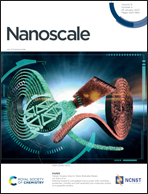Ultra-small α-CsPbI3 perovskite quantum dots with stable, bright and pure red emission for Rec. 2020 display backlights†
Abstract
The synthesis of α-CsPbI3 perovskite quantum dots (QDs) with pure red emission around 630 nm is in high demand for display backlight application. However, the phase transition of α-CsPbI3 to yellow non-emitting δ-CsPbI3 has been proven to be a great challenge for the classic colloidal synthesis route for perovskite QDs in octadecene (ODE). Herein, we report a novel colloidal synthesis route by replacing ODE with lauryl methacrylate (LMA) as the reaction solvent to improve the solubility of precursors, resulting in small sized α-CsPbI3 QDs with a diameter of only 4.2 nm, which are the smallest red PQDs reported so far. The corresponding CsPbI3 QD films exhibit a tunable photoluminescence (PL) emission peak in the bright pure red region of 627 to 638 nm. The CsPbI3 QD polymer composite films with PL emission at 630 nm exhibit a superior photoluminescence quantum yield (PLQY) and photostability to mixed halide CsPbBrI2 films under intense illumination. Perovskite light emitting diodes (LED) with the color gamut reaching 96% of the Rec. 2020 standard are achieved using these films. This study provides a high-performance pure red fluorescent material with a robust, low-cost, and reproducible colloidal chemistry that will pave the way for the adoption of perovskite QDs in display backlight application.

- This article is part of the themed collections: Celebrating 25 years of the Key Laboratory for Special Functional Materials at Henan University and Quantum Dots: A Nanoscience Nobel Prize


 Please wait while we load your content...
Please wait while we load your content...